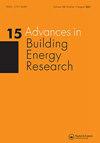二级数据中心空调系统的CFD建模
IF 2.5
Q2 CONSTRUCTION & BUILDING TECHNOLOGY
引用次数: 1
摘要
数据中心(DC)设施中空调系统(ACS)的管理不仅对能耗有重要影响,而且对硬件的性能和安全也有重要影响。这项工作的主要目的是借助计算流体动力学(CFD)工具,检测位于哥伦比亚洛斯安第斯大学(Universidad de los Andes)的二级直流系统的ACS的设计和操作缺陷。为了实现这一目标,研究人员对空气湿度和温度进行了现场测量,以开发和验证CFD模型。除了当前运行之外,还提出了两种不同的方案,并根据全球温度和相对湿度曲线、当前运行的冷却效率和气流来评估它们的性能。第一个方案设想两个空调机组在正常24小时轮班时满负荷运行,第二个方案设想对空调12小时轮班时的运行进行不稳定分析。CFD和实验结果表明,直流直流的布局和廊道布置存在一些现有ACS无法克服的缺陷。此外,所进行的CFD分析为所测试的操作装置的性能提供了相关的见解。本文章由计算机程序翻译,如有差异,请以英文原文为准。
CFD modelling of the air conditioning system for a Tier 2 Data Centre
ABSTRACT The management of Air Conditioning Systems (ACS) in Data Centre (DC) facilities has a significant impact not only on energy consumption but also on the performance and safety of the hardware. The main purpose of this work is to detect design and operational flaws of the ACS of a Tier 2 DC located at Universidad de los Andes (Colombia) with the aid of Computational Fluid Dynamics (CFD) tools. To achieve this objective, in situ measurements of air humidity and temperature were taken to develop and validate a CFD model. In addition to the current operation, two different scenarios were proposed, and their performance was evaluated in terms of the global temperature and relative humidity profiles, cooling efficiency with respect to the current operation, and air flow currents. The first scenario contemplated the operation of both AC units at full capacity for a normal 24-hour shift, and the second scenario contemplated an unsteady analysis of the AC’s operation on 12-hour shifts. The CFD and experimental results suggest that the DC’s layout and corridor arrangement have several flaws that cannot be overcome with the current ACS. Moreover, the CFD analysis carried out provides relevant insights into the performance of the operational setups tested.
求助全文
通过发布文献求助,成功后即可免费获取论文全文。
去求助
来源期刊

Advances in Building Energy Research
CONSTRUCTION & BUILDING TECHNOLOGY-
CiteScore
4.80
自引率
5.00%
发文量
11
 求助内容:
求助内容: 应助结果提醒方式:
应助结果提醒方式:


